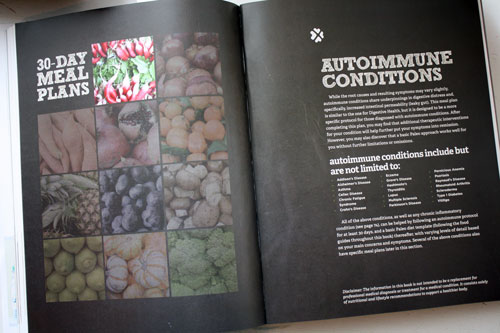Friends, I am beginning (another) journey with (another) special diet. And since so many of you followed along with my journey on the GAPS Diet, I decided to share this trip with you, too. I hope you find it informative…or at least interesting, even if only in a voyeuristic kind of way.
I have made no secret of my health troubles and write about it freely. By now, most of you are probably aware of my struggle with Ulcerative Colitis, bacterial overgrowth, and other various digestive disorders. Lest you think these chronic woes are simply “a really bad tummy-ache”, I assure you that these are debilitating illnesses that often have me laid out in bed for an entire day. I miss so much of life because of these illnesses, and because of the side-effects of the drugs to treat them.
It is my dearest wish to be able to eat food again without pain, and to have the energy and zest that I once had. So even though GAPS didn’t really work out for me, I have not stopped seeking healing. I do a lot of reading. And I do a lot of research. And I’ve found something interesting.
It might be more accurate to say that this diet found me, since I wasn’t really looking for a new diet. The one thing that GAPS did do for me was to put me more in tune to my body and how I feel after eating certain foods. I have known the effects of a few foods for years (gluten, dairy, corn, soy, beans/legumes). I knew that my body was refusing these foods and I have avoided them. But a few other foods worked on my system more subtle-y and it was impossible to tell that my body didn’t like them until I had spent months on the GAPS Intro Diet. Eggs, nuts, tomatoes, peppers, and eggplants all cause me some level of digestive distress, along with any and all grains and starches. But these foods are such a big part of my diet that I have continued to eat them anyway (with the exception of the grains and starches). The emotional benefits of consuming them, in my opinion, outweighed the physical costs to my body.
In my research, I eventually realized that what I was eating was essentially a Paleo Diet. I didn’t research, nor did I care to research, the philosophy or the science behind the Paleo Diet, and so I didn’t really attach myself to the Paleo movement. All I knew was that the food was working for me. I was basically in it for the recipes. As I browsed for recipes, I encountered various iterations of that diet to “treat” different diseases. Eventually, I found the Autoimmune Protocol (AIP), which (a-ha!) eliminates the very foods that bother me–eggs, nuts, and nightshade veggies. But the very thought of figuring out more restrictions and finding or creating more recipes was simply overwhelming. I didn’t think I could do it.
Enter, Diane Sanfilippo’s book, Practical Paleo*. This book is a New York Times Bestseller, so it doesn’t really need my review or my recommendation. This isn’t supposed to be a review post, anyway. Suffice it to say, this book is fabulous in so many ways. The recipes, the research, the readability, and most of all the meal plans! When I saw that Diane had done all of the legwork for me–created a 30-day AIP menu, provided the recipes, and even made out the shopping lists–I decided that I might be able to do this diet after all.
The last remaining obstacle was feeding my family for the 30 days that I’d be cooking (constantly) for myself. I knew I didn’t have the energy to cook separate meals 3 times a day for 30 days. I had tried that on GAPS and it didn’t work out well at all. My solution? 30-days of freezer meals for the family. I already had the best freezer cooking resource on my bookshelf. I invited a good friend (a very good friend) to join me in an all-day cooking marathon and we chopped 10 pounds of onions, browned 18 pounds of ground beef, and stuffed 30 freezer bags with fresh meals. The result? 29 days of freezer meals for my family, and one for my friend’s family–a bargain price for all of her chopping and stirring and browning.
So what is this Autoimmune Protocol anyway, and how does Ulcerative Colitis fit into it? Well, Ulcerative Colitis is now accepted as an autoimmune disorder, a disorder in which the body mistakes part of itself as a pathogen and attacks itself. Different autoimmune disorders attack different systems in the body, but the general result is inflammation in whatever system is under attack. You may be quick to brush off the term “inflammation”, thinking of the time you stubbed your toe and it got red and swollen and hurt for a while. That was acute inflammation. Your body did what it was supposed to. It was hurt, inflammation set in; things got better, inflammation went away. With autoimmune disorders we’re not talking about acute inflammation. People who suffer from autoimmune disorders have chronic inflammation. Whatever part of their body is under attack is always red, swollen, and painful.
There are some studies that suggest that autoimmune disorders can be successfully treated simply by reducing the inflammation. The science behind these studies are full of medical terminology that I don’t begin to understand (have you ever needed footnotes for the footnotes?), so I can’t explain the how’s and why’s behind those treatments. But it’s enough for me to just see someone getting results from it.
The Autoimmune Protocol supports and enables your body to reduce inflammation over a period of time. If you’re following the AIP, you don’t consume foods that are gut irritants or that trigger inflammation or immunological responses (these include grains and gluten, legumes, dairy, eggs, nuts, seeds, nightshades, caffeine, chocolate, and alcohol). And you consume a lot of the foods that are soothing to the gut lining, easy to digest, and that promote healing. In addition to diet, the AIP includes lifestyle changes to promote gentle movement and exercise and reduce stress. Stress and the wrong kind of exercise (either high-intensity or none at all) can both contribute to chronic inflammation.
Will all of this make any difference? I really don’t know. But I have a good feeling that it might be the right direction for me. Much of it represents things that I am already doing or have done in the past. But my body is in a different place now than it was. And I have new perspective and can approach this diet with new intention. Maybe it will be helpful, maybe not. But for the next few weeks I’ll be here on Mondays to report what I’m eating (and not eating), what I’m doing (and not doing), and how I’m feeling.
And, as if blatant voyeurism isn’t enough motivation for you to join me here, I’ll be hosting a giveaway of Diane’s book, Practical Paleo, sometime in March. And I know you wouldn’t want to miss that.
* This item was sent to me free of charge. The items were given to me, but I am not obligated to provide a review and the thoughts and opinions are my own. I only provide reviews of items that I find to be truly worthy of recommendation.









